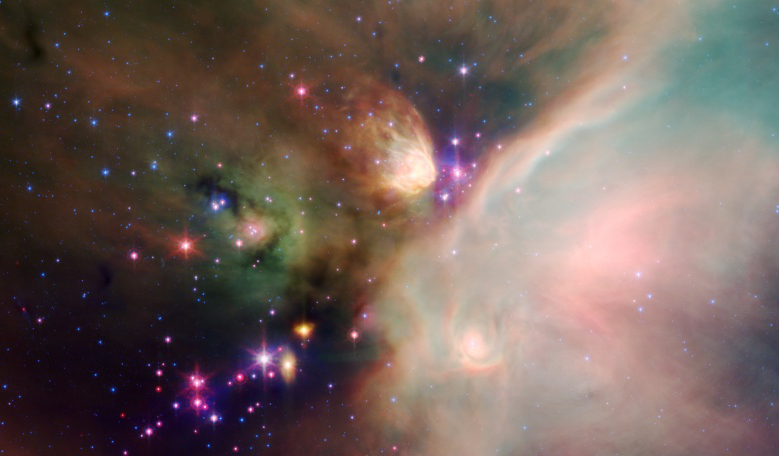The presence of radioactive material at the birth of the Solar System has been a big puzzle for the last 50 years, but now a new study which has observed a region of active star formation is giving astronomers new insights into how the heavy metals that permeate our local cosmos got here.
Studies suggest that the formation of the Solar System happened relatively fast - around a few million years from the initial collapse of a giant molecular cloud a light-year across to the creation of millions of planetesimals that would eventually form the planets.
These time constraints have been made possible by using atomic chronometers that help scientists date events. Once such chronometer is the radioactive isotope aluminum-26.
Radioactive isotopes are by their very nature unstable and will decay into daughter products, so that eventually there will be nothing left of the original product.
Aluminum-26 (26Al) for example has a half-life of only 730,000 years, meaning that all of the original aluminum-26 has long vanished and its daughter product, magnesium-27, a stable isotope, has been created along the way.
Interest in aluminum-26, which emits a gamma ray when it decays, was piqued back in the 70s when scientists examining meteorites found the isotope in calcium-aluminum-rich inclusions contained in these ancient rocks.
After concluding that they were pristine remnants of the infant solar system, the hunt has been on to find out where these heavy metals came from, and two major mechanisms emerged; the injection of 26Al from a giant active star or supernova that spewed material into interstellar space, or the irradiation of dust and gas within the Solar System.
Aiming to narrow down the answer, researchers in the US and Austria have used a number instruments including the European Southern Observatory VISTA telescope, the European Space Agency’s (ESA) Herschel Space Observatory, the ESA’s Planck satellite, and NASA’s Compton Gamma Ray Observatory to observe the interactions between the clouds in the Ophiuchus stellar nursery and the tell-tale production of gamma-rays from aluminum-26 produced in the nearest cluster of young stars across a spread of wavelengths.
“These are challenging observations. We can only convincingly detect it in two star-forming regions, and the best data are from the Ophiuchus complex,” says John Forbes at the Flatiron Institute’s Center for Computational Astrophysics and lead author of the study published this week in Nature Astronomy.
Located around 140 parsecs away, the Ophiuchus cloud complex is a haven of dense protostellar cores in various stages of star formation and protoplanetary disk development; aspects which represent the earliest stages planetary system development.
By combining the imaging data of all of the telescopes, Forbes and colleagues were able to visualise a flow of aluminum-26 from the nearby star cluster towards Ophiuchus.
“The enrichment process we’re seeing in Ophiuchus is consistent with what happened during the formation of the Solar System five billion years ago,” Forbes said.
“Although this scenario has been suggested in the past, the strength of this paper is to use multi-wavelength observations and a sophisticated statistical analysis to deduce a quantitative measurement of the model’s likelihood,” adds Douglas N. C. Lin, professor emeritus of astronomy and astrophysics at UC Santa Cruz and one of three team members involved in the research.
Once the team saw how the process might happen, Forbes developed a model that accounts for every massive star that could have existed in this region to see if it could reproduce the radionuclides scientists see today in gamma rays.
The model included the star’s mass, age, and probability of exploding as a supernova and how much aluminum-26 might have been produced from stellar winds and supernovas.
“We now have enough information to say that there is a 59 percent chance it is due to supernovas and a 68 percent chance that it’s from multiple sources and not just one supernova,” Forbes said.
Their results, notes Lin, assigns probabilities to scenarios that astronomers have been debating for the past 50 years. “This is the new direction for astronomy, to quantify the likelihood,” he said.
The model also shows that the amount of short-lived radionuclides incorporated into newly forming star systems can vary widely, a finding which could have implications for any planets that get created.
“Many new star systems will be born with aluminum-26 abundances in line with our Solar System, but the variation is huge—several orders of magnitude,” Forbes said. “This matters for the early evolution of planetary systems, since aluminum-26 is the main early heating source. More aluminum-26 probably means drier planets.”
It also means that we shouldn’t consider the Solar System as unique in any way, says the third team member João Alves from the University of Vienna. “Our results should be representative of the enrichment of short-lived radioactive elements in star and planet formation across the Milky Way. We are not that special after all, and we should expect many other Solar Systems like our own floating in the Milky Way."











